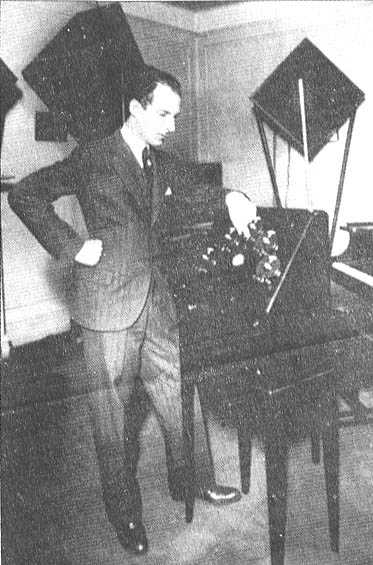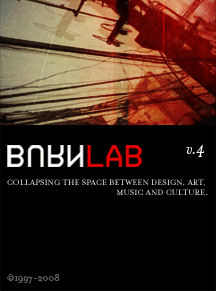[It seems that most of the posts here lately have fallen into one of three categories: design and ethics, futurism and music and things Bruce Sterling would like... which, come to think of it, most often includes the first two. Here's one that includes all three - as well as one of my other favorite topics: iconoclasts. Also, I'd like to note that this is the first post of 2008 written entirely from our back patio, and I couldn't be more excited about that!]
While gathering information for the long overdue follow-up to The Art of Noises and a separate post on art and synesthesia, I kept coming across articles on artists working shortly after and in similar spirit as the Italian Futurists, but not directly connected. It shouldn't be surprising that most of them were Russian. [I hadn't really planned on this being a post about Russian avant-garde art, but the background is critical to the later part.]
'Tatlin at Home' by Raoul Hausmann, and model of Vladimir Tatlin's 'Monument to the Third International'.
(It should be noted that Tatlin is not even present in Hausmann's portrait. The anonymous man represents the collective nature of the revolution - from the perspective of the Berlin dadaists who were fascinated with Russia at the time.)
Russian Futurists, although inspired by Marinetti's manifesto [perhaps the greatest work ever in one of my favorite mediums: hyperbole for the sake of provocation] "acknowledged no authorities whatsoever," including Marinetti himself. Russian Futurism fizzled out not long after the Bolsheviks came to power, to be followed by the brief but significant Absurdism movement OBERIU. In the years between, Constructivism [another outgrowth of Futurism] had defined perhaps the most distinctly Russian and Bolshevik friendly art movement yet. But times changed quickly, and with Stalin's rise to power the only state endorsed art was Socialist Realism, quite literally sending the avant-garde into exile.
Léon Theremin
This leads us up to the time of Lev Sergeyevich Termen - better known as Léon Theremin.
I'm going to be lazy now, because my new favorite arts and culture blog, Coilhouse has already done all the right research and put an excellent article together. Below are a few choice tidbits from Russian Industrial Music, chapters 1 and 2. [It would take way too much space to re-post the whole article, but you should definitely click and read the link to the left here. I was completely unaware of most of the the technology and music being made behind the Iron Curtain. It's seriously mind blowing.]
In 1921, Russian physicist Lev Theremin, an inventor who insisted on building all his creations by hand, constructed the theremin, one of the 20th century’s first successful electronic musical instruments and still the only music instrument whose haunting tones are elicited without touching the device. Unlike Theremin, neither famous theremin-users John Cage, Download, Brian Eno, Meat Beat Manifesto or Edgar Varese were ever arrested for its use. After a decade of teaching and performing, Theremin was suddenly seized and imprisoned in 1938 by the KGB on the grounds of “anti-Soviet Propaganda.” Theremin was sent to Siberia and later to a labor camp in Omsk, where, alongside other indentured scientists, he was forced to work on various military projects (Theremin was later given the Stalin Prize for perfecting the eavesdropping device known as “the bug”). Thus begins the history of industrial music in Russia…
[Many innovations in synthesized sound happened in Russian military research laboratories] ...the first of these inventions, a two-voiced analog music synthesizer known as EKVODIN, was conceived in the 1930s at a Russian center called TSNIATRI, or “Automatic Devices for Defense.” Its inventor, Andrei Volodin, was not a musician at all; his task had been to conduct military research in the area of psychoacoustics. In his research, Volodin needed a source of material for his experiments with human response to various sounds, and so the EKVODIN was born. Soon the device found use at the hands of musicians, and Volodin’s synthesizer almost went into mass production but, uninterested in electronic music, the Soviet State cut funding for his project in the sixties. After that, Volodin continued working on the synthesizer, but he simply did not have the energy or resources to go on - Volodin died right in his laboratory in 1982.
More success was enjoyed by the ANS – the first photoelectric synthesizer invented anywhere in the world. Designed in 1939 by Evgeney Murzin, th e technological basis of the invention lay in the synthesis of sound from an artificially drawn sound wave. Murzin was an engineer and the design of the ANS was a hobby that took 20 years to realize. Despite the fact that only one copy of the ANS was ever created, it enjoyed wide use by many Russian composers. Eerie ANS compositions by Edward Artimiev grace Tarkovsky’s sci-fi films Stalker and Solaris. In 1999, Russia’s Electroshock records released a compilation drawn from archive tapes of ANS works from 1964 - 1971. Composers on this album included Edward Artemiev, Stanislav Keitchi, and, most notably, Alfred Schnittke, whose steel-grinding-against-steel ambient-noise composition “Steam” marks the beginning of a distinctly industrial sound in Russia.
If the early industrialists in the West were fetishizing the experience of expression under control, people creating a similar sound in the USSR were living it. Separated from their counterparts by the iron curtain, musicians in Russia began composing, collaging, cutting up and programming a range of sound experiments which became the first industrial projects in the USSR at a time when such activity was prohibited by the government. Bizarrely, many of these works coincided directly with the releases of groups such as Throbbing Gristle, Z’ev, NON and Cabaret Voltaire, completely unknown in Russia at the time. This suggested that the zeitgeist of industrial culture transmitted through all boundaries of communication...
That's just the tip of the iceberg. Click here for the rest. It's essential material to anyone with interest in electronic music and/or subversive culture.
Thursday, April 17, 2008
Russian Avant-Garde, Theremin and Industrial Music
Posted by:
Unknown
at
4/17/2008 05:14:00 PM
![]()
Subscribe to:
Post Comments (Atom)

No comments:
Post a Comment